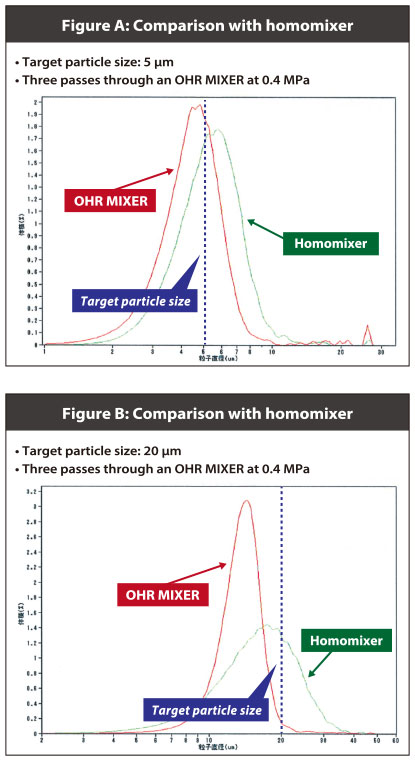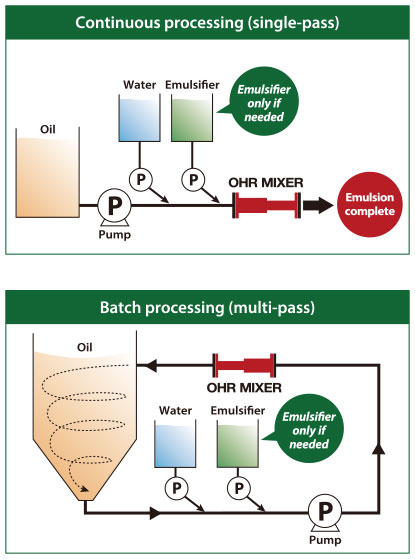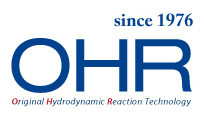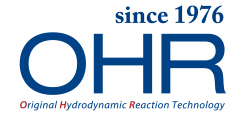[Emulsification] The only inline mixer that can replace high-pressure emulsifiers
The only inline mixer that can replace high-pressure emulsifiers
More than 300 installations on record as of June 2021
First, please take a look at the short demonstration video (below left), in which vegetable oil and water are emulsified at just 0.46 MPa without the use of chemical emulsifiers.
The OHR MIXER can thus replace high-pressure emulsification equipment simply by pairing it with a pump.
Real-world examples of the OHR MIXER’s emulsification capabilities
Light fuel oil and water can be emulsified at an extremely low pressure of 0.3 MPa

The OHR MIXER boasts impressive performance that matches or exceeds that of high-pressure emulsification equipment, while requiring just 1% of the pressure. For example, light fuel oil and water can be broken down into 2–3 μm particles and emulsified simply by passing the two of them through the OHR MIXER at a pump pressure of just 0.3 MPa — all without the addition of chemical emulsifiers.
Please direct your attention to the graphs on the right, which compare the OHR MIXER with a homomixer, a type of emulsifier whose operation is based on mechanical rotation and shear forces. Figure A displays emulsification test results for a target particle size of 5.0 microns. Figure B displays results for a target size of 20 microns.
The red (resp. green) curve shows the particle size of the emulsified liquid produced by the OHR MIXER (resp. homomixer). Notice that the OHR MIXER produces smaller particles with a narrower distribution curve, while the homomixer produces larger particles with a broader curve.
The pressure required depends on the viscosity of the target liquid. For example, for a target particle size of a few microns and a viscosity similar to that of water (~1.0 mPa·s), a pressure of 0.3 MPa will suffice. However, with a viscosity of 1,000 mPa·s, approximately 1.0 MPa of pressure is required as higher viscosity means higher flow resistance inside the OHR MIXER.
But even in this case, 1.0 MPa is still significantly lower than the 50–100 MPa typically required by high-pressure emulsifiers.
Should you desire a finer emulsion, increase the pressure or number of passes through the OHR MIXER. Since it emulsifies in a mere 0.04 seconds, multiple passes can be completed in just a few seconds. However, depending on the nature of the emulsion, increasing the number of pass-throughs may result in only a slight decrease in particle size, or none at all. Please contact us for more concrete information.
Tell us your situation and leave the details to us
We will determine the ideal model of OHR MIXER for your requirements

As the diagrams on the right illustrate, the OHR MIXER is capable of performing both continuous processing and batch processing. As for volume, anything from 10 L/min to 15,000 L/min is possible with a combination of one OHR MIXER and one pump. This is another advantage unique to the OHR MIXER, one that high-pressure emulsification equipment cannot imitate.
With the following information, we can determine the OHR MIXER model that best suits your needs. Please access the form via the link below and return it to us via email once completed.
▶ OHR MIXER checklist
- Volume of each liquid
- Relative density and viscosity of each liquid
- Details of an existing pump (if any) that you wish to use with the OHR MIXER
- Anything else of relevance (e.g. if the fluid is corrosive, any current issues, target particle size, etc)
If the created emulsion is to be used immediately, no emulsifier need be added. (In this case, the emulsion will destabilize over time and begin to separate, but this presents no issues provided that it is continually used before such separation occurs.)












